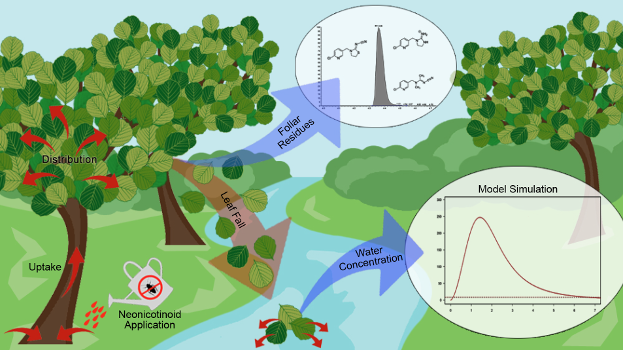In this post, we talk about our recently published paper: “Modeling Remobilization of Neonicotinoid Residues from Tree Foliage in Streams – A Relevant Exposure Pathway in Risk Assessment?“

Graphic by D. Englert
In urban and forest areas, trees are increasingly treated with systemic neonicotinoid insecticides to manage (invasive) insect pests. The neonicotinoids taken up by these trees might be released into the surrounding environment during autumn leaf fall. If these contaminated leaves enter surface water bodies, the neonicotinoids can be remobilized into the water (via leaching) consequently exposing non-target aquatic life.
To estimate the potential amount of the neonicotinoids imidacloprid, thiacloprid, and acetamiprid that might be remobilized in streams following the input of contaminated leaves, we treated black alder trees (Alnus glutinosa) in early summer with neonicotinoid insecticides and quantified their residues in leaves during the time of leaf fall. Moreover, we developed a model predicting neonicotinoid water concentrations over a 100-m-long stream stretch (as used during modeling of the European Union’s exposure assessment of pesticides; depth: 0.3 m; width: 1 m; current velocity: 0.3 m/s) as a consequence of remobilization from introduced leaves (input: 600 g leaves/m^2 containing 80 µg imidacloprid/g). In this scenario, the calculated imidacloprid water concentrations (up to ~250 ng/L) exceeded the Maximum Permissible Concentration of 8.3 ng/L for ~6.5 days. Moreover, due to the relatively long persistence of imidacloprid in submerged leaves (up to several days) we identified dietary exposure (i.e., the consumption of contaminated leaves) as potential pathway through which neonicotinoids might additionally affect aquatic organisms.
The input of neonicotinoid-contaminated plant material might even increase in the future considering the rising impact of native and invasive insect pests predicted under current climate change scenarios that might be combated for instance with neonicotinoids. Accounting for this alternative exposure route (e.g. aqueous concentrations in streams from contaminated leaves) and exposure pathways (e.g. dietary uptake through contaminated leaves) during the systemic insecticide registration process may thus help to safeguard ecosystem integrity.
The paper was authored by Dominic Englert, Nikita Bakanov, Jochen Zubrod, Ralf Schulz and Mirco Bundschuh and published in Environmental Science & Technology.
